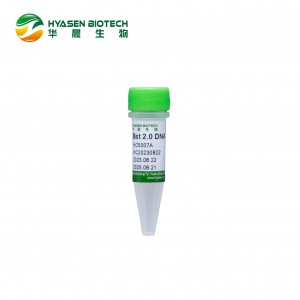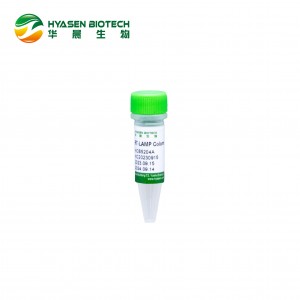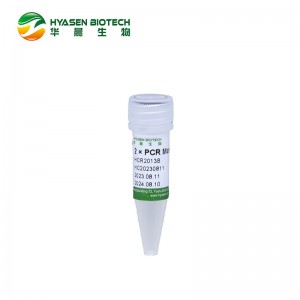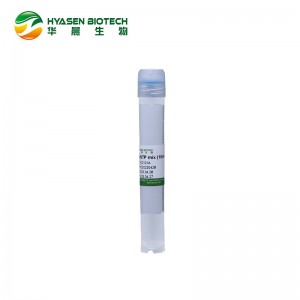
Proteinase K NGS (powder)
Cat No: HC4507A
NGS Protease K is a stable serine protease with high enzyme activity and wide substrate specificity.The enzyme preferentially decomposes ester bonds and peptide bonds adjacent to the C-terminal of hydrophobic amino acids, sulfur-containing amino acids and aromatic amino acids. So, it is often used to degrade proteins into short peptides. NGS Protease K is a typical serine protease with the Asp39-His69-Ser224 catalytic triad which is unique to serine proteases, and the catalytic center is surrounded by tow Ca2+ binding sites for stabilization, maintaining high enzyme activity under a wider range of conditions.
Specification
|
Appearance |
White to off-white amorphous powder, lyophilized |
|
Specific activity |
≥40U/mg solid |
|
DNase |
None detected |
|
RNase |
None detected |
|
Bioburden |
≤50CFU/g solid |
|
Nucleic acid residue |
<5pg/mg solid |
Properties
|
Source |
Tritirachium album |
|
EC number |
3.4.21.64 (Recombinant from Tritirachium album) |
|
Molecular weight |
29kDa (SDS-PAGE) |
|
Isoelectric point |
7.81 Fig.1 |
|
Optimum pH |
7.0-12.0 (All perform high activity) Fig.2 |
|
Optimum temperature |
65℃ Fig.3 |
|
pH Stability |
pH 4.5-12.5 (25℃,16h) Fig.4 |
|
Thermal stability |
Below 50℃ (pH 8.0, 30min) Fig.5 |
|
Storage stability |
Stored at 25℃ for 12months Fig.6 |
|
Activators |
SDS, urea |
|
Inhibitors |
Diisopropyl fluorophosphate; benzylsulfonyl fluoride |
Storage Conditions
Store the lyophilized powder at -25~-15 ℃ for a long time away from light; After dissolution, aliquot into appropriate volume for short-term storage at 2-8℃ away from light or long-term storage at -25~-15 ℃ away from light.
Precautions
Wear protective gloves and goggles when using or weighing, and keep well ventilated after use. This product may cause skin allergic reaction and serious eye irritation. If inhaled, it may cause allergy or asthma symptoms or dyspnea. May cause respiratory irritation.
Unit definition
One unit of NGS Protease K is defined as the amount of enzyme required to hydrolyze casein into 1 μmol L-tyrosine under standard determination conditions.
Reagents preparation
|
Reagent |
Manufacturer |
Catalog |
|
Casein technical from bovine milk |
Sigma Aldrich |
C7078 |
|
NaOH |
Sinopharm Chemical Reagent Co., Ltd. |
10019762 |
|
NaH2PO4 ·2H2O |
Sinopharm Chemical Reagent Co., Ltd. |
20040718 |
|
Na2HPO4 |
Sinopharm Chemical Reagent Co., Ltd. |
20040618 |
|
Trichloroacetic acid |
Sinopharm Chemical Reagent Co., Ltd. |
80132618 |
|
Sodium acetate |
Sinopharm Chemical Reagent Co., Ltd. |
10018818 |
|
Acetic acid |
Sinopharm Chemical Reagent Co., Ltd. |
10000218 |
|
HCl |
Sinopharm Chemical Reagent Co., Ltd. |
10011018 |
|
Sodium carbonate |
Sinopharm Chemical Reagent Co., Ltd. |
10019260 |
|
Foline-phenol |
Sangon Biotech (Shanghai) Co., Ltd. |
A500467-0100 |
|
L-tyrosine |
Sigma |
93829 |
Reagent I:
Substrate: 1% Casein from bovine milk solution: dissolve 1g bovine milk casein in 50ml of 0.1M sodium phosphate solution, pH 8.0, heat in water bath at 65-70 °C for 15mins, stir and dissolve, cool with water, adjusted by sodium hydroxide to pH 8.0, and dilute in to 100ml.
Reagent II:
TCA solution: 0.1M trichloroacetic acid, 0.2M sodium acetate and 0.3M acetic acid (weigh 1.64g trichloroacetic acid + 1.64g sodium acetate + 1.724mL acetic acid successively, add 50mL deionized water, adjust with HCl to pH 4.03, and dilute into 100ml).
Reagent III:
0.4m sodium carbonate solution (weigh 4.24g anhydrous sodium carbonate and dissolve in 100mL water)
Reagent IV:
Folin phenol reagent: dilute 5 times with deionized water.
Reagent V:
Enzyme diluent: 0.1 M sodium phosphate solution, pH 8.0.
Reagent VI:
L-tyrosine standard solution:0, 0.005, 0.025, 0.05, 0.075, 0.1, 0.25 umol/ml L-tyrosine dissolved with 0.2M HCl.
Procedure
1. Turn on the UV-Vis spectrophotometer and select photometric measurement.
2. Set the wavelength as 660nm.
3. Turn on the water bath, set the temperature to 37℃, ensure the temperature unchanged for 3-5mins.
4. Preheat 0.5mL substrate in a 2mL centrifuge tube at 37℃ water bath for 10mins.
5. Extract 0.5mL diluted enzyme solution into the preheated centrifuge tube for 10 minutes. Set enzyme diluent as blank group.
6. Add 1.0 mL TCA reagent immediately after the reaction. Mix well and incubate in water bath for 30 minutes.
7. Centrifugate reaction solution.
8. Add the following components in the order specified.
|
Reagent |
Volume |
|
Supernatant |
0.5 mL |
|
0.4M Sodium carbonate |
2.5 mL |
|
Folin phenol reagent |
0.5 mL |
9. Mix well before incubating in water bath a 37℃ for 30 mins.
10. OD660 was determined as OD1; blank control group: Enzyme diluent is used to replace enzyme solution to determine OD660 as OD2, ΔOD=OD1-OD2.
11. L-tyrosine standard curve: 0.5mL different concentration L-tyrosine solution, 2.5mL 0.4M Sodium carbonate, 0.5mL Folin phenol reagent in 5mL centrifuge tube, incubate in 37℃ for 30mins, detect for OD660 for different concentration of L-tyrosine, then obtained the standard curve Y=kX+b,where Y is the L-tyrosine concentration, X is OD600.
Calculation
2: Total volume of reaction solution (mL)
0.5: Volume of enzyme solution (mL)
0.5: Reaction liquid volume used in chromogenic determination (mL)
10: Reaction time (min)
Df: Dilution multiple
C: Enzyme concentration (mg/mL)
Figures
Fig.1 DNA residue
|
Sample |
Ave C4 |
Nucleic Acid Recovery(pg/mg) |
Recovery(%) |
Total Nucleic Acid ( pg/mg) |
|
PRK |
24.66 |
2.23 |
83% |
2.687 |
|
PRK+STD2 |
18.723 |
126.728 |
— |
— |
|
STD1 |
12.955 |
— |
— |
— |
|
STD2 |
16 |
|||
|
STD3 |
19.125 |
|||
|
STD4 |
23.135 |
|||
|
STD5 |
26.625 |
|||
|
RNA-Free H2O |
Undetermined |
— |
— |
— |
Fig.2 Optimum pH
Fig.3 Optimum temperature
Fig.4 pH Stability
Fig.5 Thermal stability
Fig.6 Storage stability at 25℃















